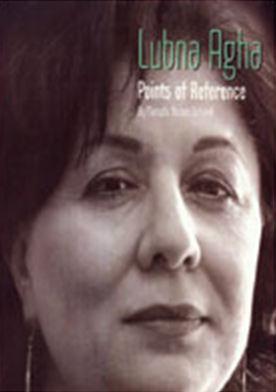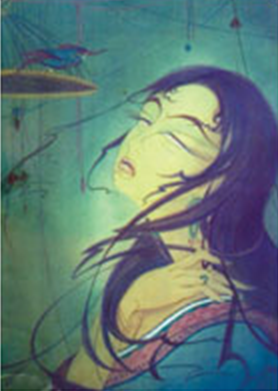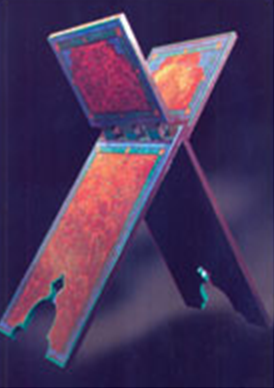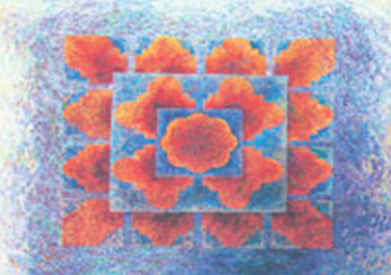Lubna Agha
(Created page with "{| class="wikitable" |- |colspan="0"|<div style="font-size:100%"> This is a collection of articles archived for the excellence of their content.<br/>You can help by converting...") |
|||
| Line 32: | Line 32: | ||
Soon after Lubna started classes at the Mina Art School, she was joined by another girl and then her own sister. In all, there were seven or eight students working in close relationship with the teachers. The structure of the programme was like an apprenticeship for the students who had been taken under the wings of their teachers. There were definite advantages being part of a small group in a fledgling art institution. Lubna and her classmates got a great deal of attention from Rabia Zuberi, the first principal of the art school and co-founder with her sister Hajra. Mansur Rahi, another of Lubna’s teachers, became principal in 1965. Based on his university background and artistic experience, he refined the curriculum, renamed the institution Karachi School of Art and in 1969 married Hajra Zuberi. The faculty comprised a unique combination of geographic backgrounds and artistic expertise ... | Soon after Lubna started classes at the Mina Art School, she was joined by another girl and then her own sister. In all, there were seven or eight students working in close relationship with the teachers. The structure of the programme was like an apprenticeship for the students who had been taken under the wings of their teachers. There were definite advantages being part of a small group in a fledgling art institution. Lubna and her classmates got a great deal of attention from Rabia Zuberi, the first principal of the art school and co-founder with her sister Hajra. Mansur Rahi, another of Lubna’s teachers, became principal in 1965. Based on his university background and artistic experience, he refined the curriculum, renamed the institution Karachi School of Art and in 1969 married Hajra Zuberi. The faculty comprised a unique combination of geographic backgrounds and artistic expertise ... | ||
| − | + | ||
Lubna’s artistic abilities were recognised during her art student years. In 1966, the year before graduation, she received no fewer than five awards. The watercolour portrait of a beauty in the manner of Chughtai won her first prize. Hajra Zuberi’s influence was apparent, but the difficult technique of overlaid washes and subtle colouration attested to Lubna’s commitment of mastering the medium. In addition of classroom assignments, Lubna and her classmates went to Bohri Bazaar to paint street scenes and architecture. They always attracted a crowd and the occasional amateur critic who commented on size or colour or verity of similitude! | Lubna’s artistic abilities were recognised during her art student years. In 1966, the year before graduation, she received no fewer than five awards. The watercolour portrait of a beauty in the manner of Chughtai won her first prize. Hajra Zuberi’s influence was apparent, but the difficult technique of overlaid washes and subtle colouration attested to Lubna’s commitment of mastering the medium. In addition of classroom assignments, Lubna and her classmates went to Bohri Bazaar to paint street scenes and architecture. They always attracted a crowd and the occasional amateur critic who commented on size or colour or verity of similitude! | ||
An accomplished landscape panorama, Under the Golimar Bridge, one of hundreds of assignments undertaken during Lubna’s four years in art school, reflected the influence of teacher Mansur Rahi. The strong outlines and rhythmic configurations that characterized Rahi’s own highly stylized figurative motifs were evident in Lubna’s landscape. | An accomplished landscape panorama, Under the Golimar Bridge, one of hundreds of assignments undertaken during Lubna’s four years in art school, reflected the influence of teacher Mansur Rahi. The strong outlines and rhythmic configurations that characterized Rahi’s own highly stylized figurative motifs were evident in Lubna’s landscape. | ||
| + | |||
| + | [[File:Lubna Agha1.png| Lubna Agha |frame|left|500px]] | ||
She has groped her way through the stages of work, dealing with the insecurity of taking artistic risks. She has pondered what it means to be a mature artist, asking questions such as how long she should stay with a style or whether nature can be a source of abstraction and non-figuration. | She has groped her way through the stages of work, dealing with the insecurity of taking artistic risks. She has pondered what it means to be a mature artist, asking questions such as how long she should stay with a style or whether nature can be a source of abstraction and non-figuration. | ||
| − | |||
| − | |||
These two examples of student art, pristine in execution and diverse in style and subject, reflected the curriculum and philosophy at the Karachi School of Art. Students were required to learn techniques of all fine art media. They were expected to sample a diversity of subject matter as well, from figures and portraits to landscapes and still lifes. Above all, the young artists were steeped in draftsmanship ... | These two examples of student art, pristine in execution and diverse in style and subject, reflected the curriculum and philosophy at the Karachi School of Art. Students were required to learn techniques of all fine art media. They were expected to sample a diversity of subject matter as well, from figures and portraits to landscapes and still lifes. Above all, the young artists were steeped in draftsmanship ... | ||
| + | |||
| + | [[File:Lubna Agha2.png| Lubna Agha |frame|500px]] | ||
With a programme dedicated to mastering the basics, the Karachi School of Art boasted phenomenal success for its graduates, particularly in commercial and graphic design careers. Lubna was the first graduate to make a name as an independent artist. In 1967, the year she graduated, Lubna held he first solo exhibition at the Pakistan-American Cultural Centre. Reviews in newspapers commented on the diversity of media and subjects seen in the 70 works which were exhibited. There were watercolours and ink paintings, pencil drawings and woodcut prints ... There was realism and abstraction and several very meticulous and skilled anatomical studies. In addition to making her own art, Lubna was teaching at the Central Institute of Art in Karachi. Two years later her life and her art changed dramtically. | With a programme dedicated to mastering the basics, the Karachi School of Art boasted phenomenal success for its graduates, particularly in commercial and graphic design careers. Lubna was the first graduate to make a name as an independent artist. In 1967, the year she graduated, Lubna held he first solo exhibition at the Pakistan-American Cultural Centre. Reviews in newspapers commented on the diversity of media and subjects seen in the 70 works which were exhibited. There were watercolours and ink paintings, pencil drawings and woodcut prints ... There was realism and abstraction and several very meticulous and skilled anatomical studies. In addition to making her own art, Lubna was teaching at the Central Institute of Art in Karachi. Two years later her life and her art changed dramtically. | ||
| − | [[File:Lubna | + | [[File:Lubna Agha3.png| Lubna Agha |frame|left|500px]] |
As a mature artist, Lubna sees clearly where she has been and says frequently that all the work that went before has led her to this new phase. It is a culmination of her artistic life to the present time. “A lot of work has been personal in nature. However, I feel the seeds of my imagination come from the soil of my birth … My recent work explores the beauty of my Islamic roots.” Finding those Islamic roots has become paramount to her as she embraces the artistic heritage of Pakistan and Muslim culture. In the intense colour and rich pattern seen on the rehel, she embraces meticulous craftsmanship and design. The joyous colours show her complete involvement in her new work — it is making Islamic art and architecture personal. She has foresworn the speed of the 21st century, choosing instead time-consuming, labour-intensive devotion to historic practice. Each daub of paint relives for example, the process of a craftsman beating on a piece of metal, both in the physical action and in the historic concept. Each stroke becomes important because it represents the physical act of making. | As a mature artist, Lubna sees clearly where she has been and says frequently that all the work that went before has led her to this new phase. It is a culmination of her artistic life to the present time. “A lot of work has been personal in nature. However, I feel the seeds of my imagination come from the soil of my birth … My recent work explores the beauty of my Islamic roots.” Finding those Islamic roots has become paramount to her as she embraces the artistic heritage of Pakistan and Muslim culture. In the intense colour and rich pattern seen on the rehel, she embraces meticulous craftsmanship and design. The joyous colours show her complete involvement in her new work — it is making Islamic art and architecture personal. She has foresworn the speed of the 21st century, choosing instead time-consuming, labour-intensive devotion to historic practice. Each daub of paint relives for example, the process of a craftsman beating on a piece of metal, both in the physical action and in the historic concept. Each stroke becomes important because it represents the physical act of making. | ||
| − | [[File:Lubna | + | [[File:Lubna Agha4.png| Lubna Agha |frame|500px]] |
What Lubna has accomplished is remarkable because she achieved fame as an 18-year-old girl, at a time when there were so few other important women artists in Pakistan. She has groped her way through the stages of work, dealing with the insecurity of taking artistic risks. She has pondered what it means to be a mature artist, asking questions such as how long she should stay with a style or whether nature can be a source of abstraction and non-figuration, without these parameters having been established in her native country. | What Lubna has accomplished is remarkable because she achieved fame as an 18-year-old girl, at a time when there were so few other important women artists in Pakistan. She has groped her way through the stages of work, dealing with the insecurity of taking artistic risks. She has pondered what it means to be a mature artist, asking questions such as how long she should stay with a style or whether nature can be a source of abstraction and non-figuration, without these parameters having been established in her native country. | ||
| − | |||
| − | |||
Her current work reflects the new freedom which Lubna feels. She has long since established herself as an artist, she has raised her family, and she has overcome the difficulties inherent in living in the United States, away from her native land. Her recent travels in Morocco and Turkey opened her eyes to the common heritage Islamic countries share. While each is unique in its own right, she recognises the commonalities of architectural forms, patterns and cultural objects. This allows her to reclaim overlooked objects of Islamic culture and give them a new life. The yearning she felt for deeper spirituality in her life is particularly embraced in this new work. | Her current work reflects the new freedom which Lubna feels. She has long since established herself as an artist, she has raised her family, and she has overcome the difficulties inherent in living in the United States, away from her native land. Her recent travels in Morocco and Turkey opened her eyes to the common heritage Islamic countries share. While each is unique in its own right, she recognises the commonalities of architectural forms, patterns and cultural objects. This allows her to reclaim overlooked objects of Islamic culture and give them a new life. The yearning she felt for deeper spirituality in her life is particularly embraced in this new work. | ||
Revision as of 18:23, 8 November 2013
This is a collection of articles archived for the excellence of their content. Readers will be able to edit existing articles and post new articles directly |
Lubna Agha
December 24, 2006
EXCERPTS: Different strokes
A monograph capturing the artistic journey of Lubna Agha.
Marcella Nesom Sirhandi retraces Lubna Agha’s first few steps into the world of art.
As a young girl, barely into her teens, Lubna Latif knew she wanted to be an artist. She was born in Quetta in 1949, and the family moved about in Pakistan during her youth. Her father was a customs officer in government service, posted first to Sargodha, then Multan, Lahore and Landi Kotal. They finally settled in Karachi in 1961 when Lubna was 12 years old. A few years later, Lubna enrolled as the first student at the newly formed Mina Art School in Karachi. She went to public school in the morning and took art classes in the afternoon. When the art school became accredited and changed its name to Karachi School of Arts, Lubna dropped out of high school and became a full-time art student. Her parents resisted at first, but soon relented and fully supported her decision. Lubna elected to forego high school graduation and earned a diploma from the Karachi School of Arts instead …
Soon after Lubna started classes at the Mina Art School, she was joined by another girl and then her own sister. In all, there were seven or eight students working in close relationship with the teachers. The structure of the programme was like an apprenticeship for the students who had been taken under the wings of their teachers. There were definite advantages being part of a small group in a fledgling art institution. Lubna and her classmates got a great deal of attention from Rabia Zuberi, the first principal of the art school and co-founder with her sister Hajra. Mansur Rahi, another of Lubna’s teachers, became principal in 1965. Based on his university background and artistic experience, he refined the curriculum, renamed the institution Karachi School of Art and in 1969 married Hajra Zuberi. The faculty comprised a unique combination of geographic backgrounds and artistic expertise ...
Lubna’s artistic abilities were recognised during her art student years. In 1966, the year before graduation, she received no fewer than five awards. The watercolour portrait of a beauty in the manner of Chughtai won her first prize. Hajra Zuberi’s influence was apparent, but the difficult technique of overlaid washes and subtle colouration attested to Lubna’s commitment of mastering the medium. In addition of classroom assignments, Lubna and her classmates went to Bohri Bazaar to paint street scenes and architecture. They always attracted a crowd and the occasional amateur critic who commented on size or colour or verity of similitude!
An accomplished landscape panorama, Under the Golimar Bridge, one of hundreds of assignments undertaken during Lubna’s four years in art school, reflected the influence of teacher Mansur Rahi. The strong outlines and rhythmic configurations that characterized Rahi’s own highly stylized figurative motifs were evident in Lubna’s landscape.
She has groped her way through the stages of work, dealing with the insecurity of taking artistic risks. She has pondered what it means to be a mature artist, asking questions such as how long she should stay with a style or whether nature can be a source of abstraction and non-figuration.
These two examples of student art, pristine in execution and diverse in style and subject, reflected the curriculum and philosophy at the Karachi School of Art. Students were required to learn techniques of all fine art media. They were expected to sample a diversity of subject matter as well, from figures and portraits to landscapes and still lifes. Above all, the young artists were steeped in draftsmanship ...
With a programme dedicated to mastering the basics, the Karachi School of Art boasted phenomenal success for its graduates, particularly in commercial and graphic design careers. Lubna was the first graduate to make a name as an independent artist. In 1967, the year she graduated, Lubna held he first solo exhibition at the Pakistan-American Cultural Centre. Reviews in newspapers commented on the diversity of media and subjects seen in the 70 works which were exhibited. There were watercolours and ink paintings, pencil drawings and woodcut prints ... There was realism and abstraction and several very meticulous and skilled anatomical studies. In addition to making her own art, Lubna was teaching at the Central Institute of Art in Karachi. Two years later her life and her art changed dramtically.
As a mature artist, Lubna sees clearly where she has been and says frequently that all the work that went before has led her to this new phase. It is a culmination of her artistic life to the present time. “A lot of work has been personal in nature. However, I feel the seeds of my imagination come from the soil of my birth … My recent work explores the beauty of my Islamic roots.” Finding those Islamic roots has become paramount to her as she embraces the artistic heritage of Pakistan and Muslim culture. In the intense colour and rich pattern seen on the rehel, she embraces meticulous craftsmanship and design. The joyous colours show her complete involvement in her new work — it is making Islamic art and architecture personal. She has foresworn the speed of the 21st century, choosing instead time-consuming, labour-intensive devotion to historic practice. Each daub of paint relives for example, the process of a craftsman beating on a piece of metal, both in the physical action and in the historic concept. Each stroke becomes important because it represents the physical act of making.
What Lubna has accomplished is remarkable because she achieved fame as an 18-year-old girl, at a time when there were so few other important women artists in Pakistan. She has groped her way through the stages of work, dealing with the insecurity of taking artistic risks. She has pondered what it means to be a mature artist, asking questions such as how long she should stay with a style or whether nature can be a source of abstraction and non-figuration, without these parameters having been established in her native country.
Her current work reflects the new freedom which Lubna feels. She has long since established herself as an artist, she has raised her family, and she has overcome the difficulties inherent in living in the United States, away from her native land. Her recent travels in Morocco and Turkey opened her eyes to the common heritage Islamic countries share. While each is unique in its own right, she recognises the commonalities of architectural forms, patterns and cultural objects. This allows her to reclaim overlooked objects of Islamic culture and give them a new life. The yearning she felt for deeper spirituality in her life is particularly embraced in this new work.
Excerpted with permission from Lubna Agha: Points of Reference By Marcella Nesom Sirhandi Foundation of Museum of Modern Art (FOMMA) in association with East-West University Press, Chicago Available with FOMMA, Lakson Square, Building # 2, Sarwar Shaheed Road, Karachi-74200 Tel: 021-5698110 fomma@hotmail.com ISBN 969-8896-01-5 70pp. Price not listed
Marcella Nesom Sirhandi has a PhD in Asian art history and teaches the subject at Oklahoma State University in the US. Her first book was titled Contemporary Painting in Pakistan. She is currently working on a book on new miniature painting in Pakistan.
Lubna Agha II
The diaspora syndrome
By Salwat Ali
Today a considerable amount of contemporary art belongs to artists located in the Diaspora. As a practicing artist, Lubna Agha was painting her diaspora years before the term gained currency and acceptance that it now enjoys. A Fomma monograph, ‘Points of Reference’ by Marcella Nesom Sirhindi traces Agha’s aesthetic evolution and progression of her stylistic shifts but it is the soul baring details of her dislocation that bring grip to the volume.
The early years of Agha’s emergence as an artist are fairly well documented and viewers here are familiar with her white paintings but in 1981, along with her family, she moved to Sacramento, California, USA where she went through the second most important change in her artistic life. Here, after serious engagement with organic abstraction so central to her white paintings, she returned to figuration. Ali Imam had called Lubna, “an artist on the run, passing from phase to phase” but in Marcella’s text we are able to discover the reality behind the shift.
Artists are intimately associated with their immediate environment and Pakistan for Lubna was home where she was settled with her family and had friends, relatives and a successful career as a practicing artist. Sacramento was a strange new environment where the family had to make ends meet on a limited budget in cramped housing amongst strangers. “A life that was whole became fragmented” and Lubna, overwhelmed by the displacement, poured her heart out into her canvases.
Marcella narrates an incident where well known California artist Wayne Theibauld on viewing her figurative painting questioned “Why are none of your figures grounded? To which Lubna responded “I recently came from Pakistan and don’t have my bearings here yet. It’s a metaphor.” But there was more to this painting called ‘Tree of Life’ than just the lack of gravity.
The author writes that, “Her nudes were not just carefree spirits but in the grasp of an inner turmoil. Some covered their faces while others were upside down and floating. Their gestures and postures symbolized difficulty in adjusting to their surroundings. The imagery reflected Lubna’s own personal discomfort in her new home. The tree was nature, the reliable constant she had always clung to. It also represented her heritage.”
Other works of the same period like ‘Doli’, ‘Roots’ and ‘Falling’ went beyond personal dislocation to allied sentiments like nostalgia, longing for home and addressing of personal suffering through cultural statements and socio political critique pertaining to homeland issues. The most telling among these was ‘Three Days’, Lubna’s expression of the three phases of life pertaining to birth, struggle for existence and death. “The foetus and umbilical cord were the connection to her cultural heritage, the continuation of life and thread between generations. The chevron — designed trees harboured roots that provided further connections to her homeland, family and friends.”
Incorporating computer language into the painterly exercise is a common feature now but as early as the mid 1990s the Mac11 influence was manifest in Lubna’s oil painting with the computerized phrase ‘Fragmentation Disintegration’ super imposed over the painted surface.
Lubna Agha’s art was a product of her peculiar situation, a Muslim in a western environment. It manifested influences of a life dominated by career advancement, technological developments in art as well as a deep sensitivity to global politics and its affects on the Muslim population worldwide and in the subcontinent. Paintings like ‘Sarajevo’ and later the Ja-namaz series, especially ‘Ja- namaz and the White House’ and another with McDonald’s Golden Arches and still another with the IMF logo were very direct interpretations of this phenomenon.
Her current phase ‘Infinity and Oneness’ is a far cry from the cubist abstraction, semi realistic figuration and extensive recourse to symbols from nature that she formerly played with a serious intent and purpose. Lubna’s new work is defined by a desire to translate Islamic religious and cultural heritage with a fresh vision. Marcella writes that the “fresh vision had less to do with iconography and design than with process and craftsmanship.” Even though the narrative element is entirely absent from the chromatically vibrant visuals in the Infinity chapter they still have a passionate eloquence about them.
Agha is an artist with tremendous emotive capacity and Marcella Sirhindi captures this with due sensitivity in her monograph. The artist’s absence from the Pakistani art scene is also reason enough to read the volume. It completes an unfinished picture.




